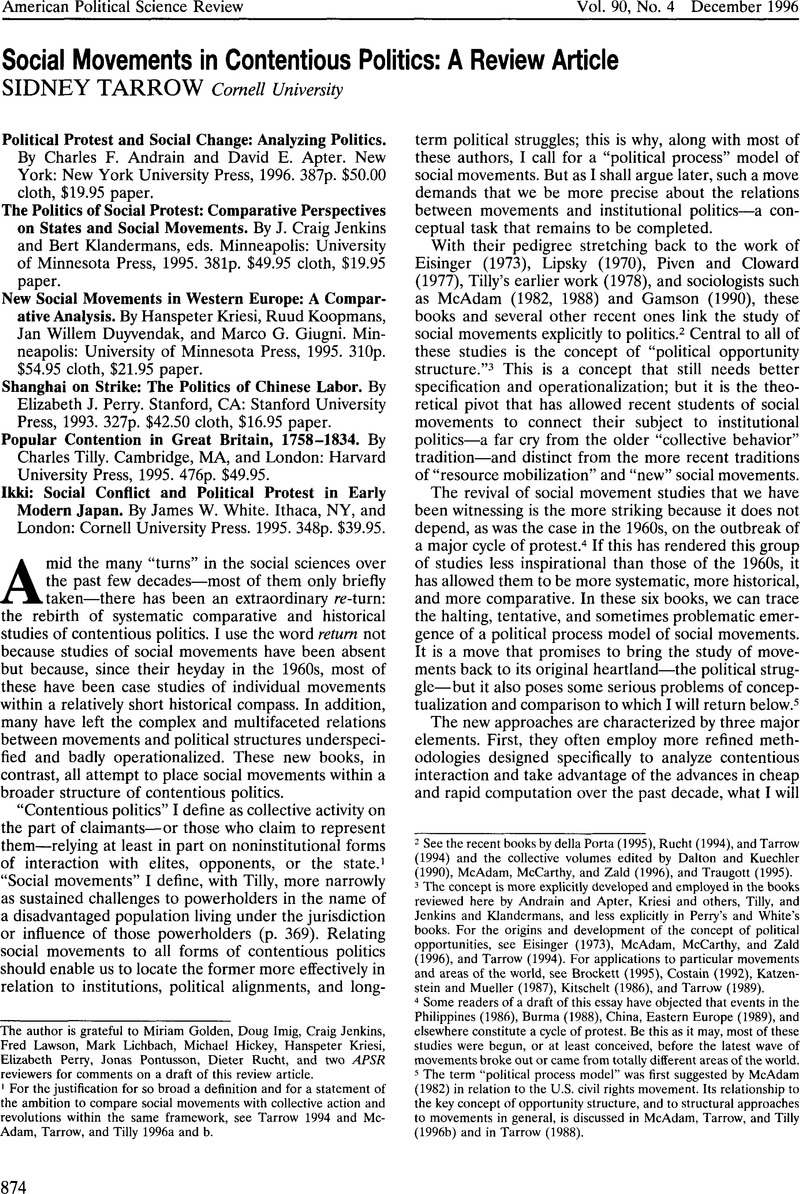Crossref Citations
This article has been cited by the following publications. This list is generated based on data provided by Crossref.
Lichbach, Mark I.
1998.
CONTENDING THEORIES OF CONTENTIOUS POLITICS AND THE STRUCTURE-ACTION PROBLEM OF SOCIAL ORDER.
Annual Review of Political Science,
Vol. 1,
Issue. 1,
p.
401.
Silva, Eduardo
1998.
The Politics of Environment and Development.
Latin American Research Review,
Vol. 33,
Issue. 3,
p.
230.
Giugni, Marco G.
1998.
Was it Worth the Effort? The Outcomes and Consequences of Social Movements.
Annual Review of Sociology,
Vol. 24,
Issue. 1,
p.
371.
Ayres, Jeffrey M.
1999.
From the Streets to the Internet: The Cyber-Diffusion of Contention.
The ANNALS of the American Academy of Political and Social Science,
Vol. 566,
Issue. 1,
p.
132.
Houtzager, Peter P.
2000.
Social movements amidst democratic transitions: Lessons from the Brazilian countryside.
Journal of Development Studies,
Vol. 36,
Issue. 5,
p.
59.
Sommer, Henrik
2000.
Bringing nonviolence back into the study of contentious politics.
Politikon,
Vol. 27,
Issue. 2,
p.
255.
Dellapenna, Joseph W.
2000.
Law in a Shrinking World: The Interaction of Science and Technology with International Law.
SSRN Electronic Journal ,
Ho, K. C.
Baber, Zaheer
and
Khondker, Habibul
2002.
‘Sites’ of resistance: alternative websites and state‐society relations 1.
The British Journal of Sociology,
Vol. 53,
Issue. 1,
p.
127.
Rojecki, Andrew
2002.
Modernism, state sovereignty and dissent: media and the new post-cold war movements.
Critical Studies in Media Communication,
Vol. 19,
Issue. 2,
p.
152.
Brainard, Lori A.
and
Siplon, Patricia D.
2002.
Cyberspace Challenges to Mainstream Nonprofit Health Organizations.
Administration & Society,
Vol. 34,
Issue. 2,
p.
141.
Barany, Zoltan
2002.
Ethnic Mobilization without Prerequisites: The East European Gypsies.
World Politics,
Vol. 54,
Issue. 3,
p.
277.
Silva, Eduardo
Kaimowitz, David
Bojanic, Alan
Ekoko, Francois
Manurung, Togu
and
Pavez, Iciar
2002.
Making the Law of the Jungle: The Reform of Forest Legislation in Bolivia, Cameroon, Costa Rica, and Indonesia..
Global Environmental Politics,
Vol. 2,
Issue. 3,
p.
63.
Earl, Jennifer
Soule, Sarah A.
and
McCarthy, John D.
2003.
Protest under Fire? Explaining the Policing of Protest.
American Sociological Review,
Vol. 68,
Issue. 4,
p.
581.
Tarrow, Sidney
2003.
Crossing the Ocean and Back Again with Piven and Cloward.
Perspectives on Politics,
Vol. 1,
Issue. 4,
p.
711.
Hoover, Dennis R.
and
den Dulk, Kevin R.
2004.
Christian Conservatives Go to Court:Religion and Legal Mobilization in the united States and Canada.
International Political Science Review,
Vol. 25,
Issue. 1,
p.
9.
Earl, Jennifer
Martin, Andrew
McCarthy, John D.
and
Soule, Sarah A.
2004.
The Use of Newspaper Data in the Study of Collective Action.
Annual Review of Sociology,
Vol. 30,
Issue. 1,
p.
65.
Saxton, Gregory D.
2004.
Structure, Politics, and Ethnonationalist Contention in Post-Franco Spain: An Integrated Model.
Journal of Peace Research,
Vol. 41,
Issue. 1,
p.
25.
Ayres, Jeffrey M.
2005.
Vol. 26,
Issue. ,
p.
35.
Kudva, Neema
2006.
Shaping Democracy through Organizational Practice.
International Journal of Rural Management,
Vol. 2,
Issue. 2,
p.
227.
Velasco Jaramillo, Marcela
2007.
Cambio constitucional y capacidades institucionales: un análisis de la protesta social en Colombia.
Opinião Pública,
Vol. 13,
Issue. 1,
p.
124.






Comments
No Comments have been published for this article.